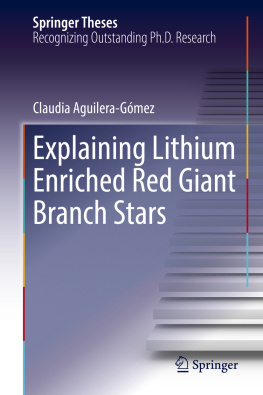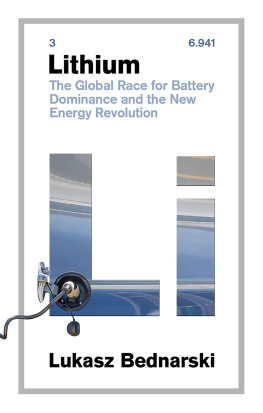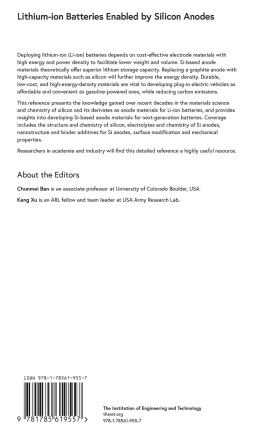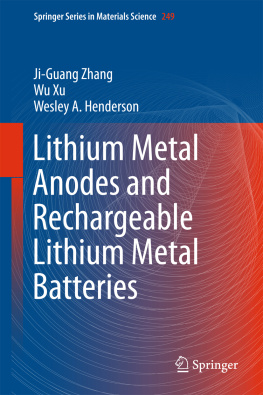Claudia Aguilera-Gómez - Explaining Lithium Enriched Red Giant Branch Stars
Here you can read online Claudia Aguilera-Gómez - Explaining Lithium Enriched Red Giant Branch Stars full text of the book (entire story) in english for free. Download pdf and epub, get meaning, cover and reviews about this ebook. year: 2018, publisher: Springer, genre: Science. Description of the work, (preface) as well as reviews are available. Best literature library LitArk.com created for fans of good reading and offers a wide selection of genres:
Romance novel
Science fiction
Adventure
Detective
Science
History
Home and family
Prose
Art
Politics
Computer
Non-fiction
Religion
Business
Children
Humor
Choose a favorite category and find really read worthwhile books. Enjoy immersion in the world of imagination, feel the emotions of the characters or learn something new for yourself, make an fascinating discovery.
- Book:Explaining Lithium Enriched Red Giant Branch Stars
- Author:
- Publisher:Springer
- Genre:
- Year:2018
- Rating:3 / 5
- Favourites:Add to favourites
- Your mark:
- 60
- 1
- 2
- 3
- 4
- 5
Explaining Lithium Enriched Red Giant Branch Stars: summary, description and annotation
We offer to read an annotation, description, summary or preface (depends on what the author of the book "Explaining Lithium Enriched Red Giant Branch Stars" wrote himself). If you haven't found the necessary information about the book — write in the comments, we will try to find it.
Explaining Lithium Enriched Red Giant Branch Stars — read online for free the complete book (whole text) full work
Below is the text of the book, divided by pages. System saving the place of the last page read, allows you to conveniently read the book "Explaining Lithium Enriched Red Giant Branch Stars" online for free, without having to search again every time where you left off. Put a bookmark, and you can go to the page where you finished reading at any time.
Font size:
Interval:
Bookmark:
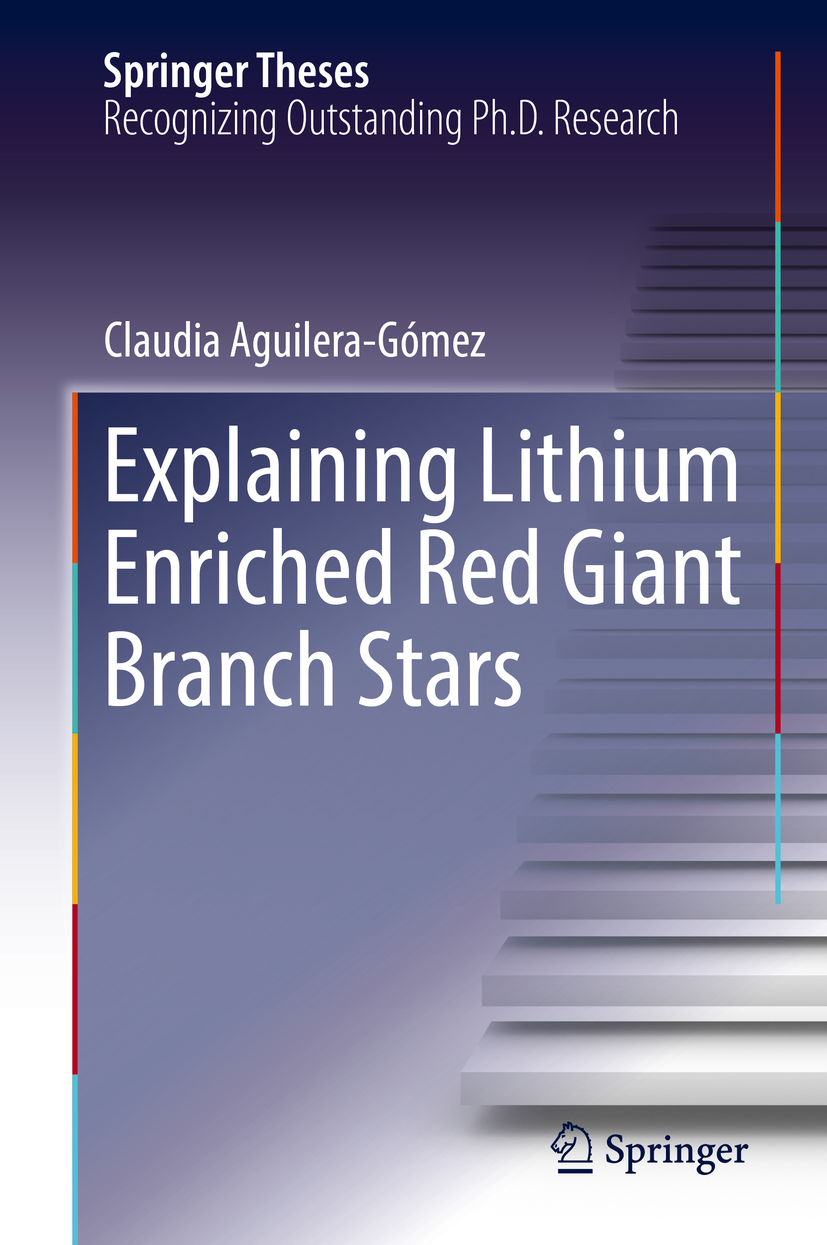
Aims and Scope
The series Springer Theses brings together a selection of the very best Ph.D. theses from around the world and across the physical sciences. Nominated and endorsed by two recognized specialists, each published volume has been selected for its scientific excellence and the high impact of its contents for the pertinent field of research. For greater accessibility to non-specialists, the published versions include an extended introduction, as well as a foreword by the students supervisor explaining the special relevance of the work for the field. As a whole, the series will provide a valuable resource both for newcomers to the research fields described, and for other scientists seeking detailed background information on special questions. Finally, it provides an accredited documentation of the valuable contributions made by todays younger generation of scientists.
They must be written in good English.
The topic should fall within the confines of Chemistry, Physics, Earth Sciences, Engineering and related interdisciplinary fields such as Materials, Nanoscience, Chemical Engineering, Complex Systems and Biophysics.
The work reported in the thesis must represent a significant scientific advance.
If the thesis includes previously published material, permission to reproduce this must be gained from the respective copyright holder.
They must have been examined and passed during the 12 months prior to nomination.
Each thesis should include a foreword by the supervisor outlining the significance of its content.
The theses should have a clearly defined structure including an introduction accessible to scientists not expert in that particular field.
More information about this series at http://www.springer.com/series/8790

This Springer imprint is published by the registered company Springer Nature Switzerland AG
The registered company address is: Gewerbestrasse 11, 6330 Cham, Switzerland
The current theory of stellar structure and evolution was born and grew up along with the revolutions of modern and quantum physics of the early twentieth century. It is arguably one of the most successful physical frameworks of modern astrophysics, explaining the inner workings of stars of all sizes and chemical compositions to a remarkably high level of agreement between theory and observation. The model not only accounts for the detailed interior of stars at any given time (their structure, state of the matter, energy generation, energy transport, internal dynamics) but also successfully explains precisely why and how these properties change in time almost since stars are born until their ultimate fate in a universe of a finite age. Moreover, when the machinery of the model is applied to large collections of stars, we are able to understand the behavior of the stellar populations that make up and drive the evolution of the variety of galaxies whose studies, in turn, teach us about cosmology and even provide tests of some of the fundamental physics on which the theory itself rests. Today, our understanding of stellar interiors is being further boosted by the maturity of the tool of asteroseismology, which provides a new ability to peer into the structure and dynamics of stellar interiors. At the same time, the asteroseismic advances on stellar astrophysics, along with the present astrometric revolution being enabled by the Gaia mission and various large spectroscopic surveys, are leading us today into a new era in the understanding of the formation, structure, and evolution of the Milky Way galaxy as a whole. Modern stellar astrophysics, therefore, is an extremely robust construction that keeps improving and upon which new and larger astrophysical enterprises rest. In this context, long-standing unsolved problems in the area are few, and any new advances that offer truly novel insight on those problems are, not surprisingly, extremely rare. Claudia Aguilera-Gmezs PhD thesis work is one of these rarities.
The existence of a small but ubiquitous fraction of red giant stars with large amounts of lithium in their surfaces is among those few old problems in stellar astrophysics that have eluded an explanation for a few decades now. The problem is made the more difficult due to the fact that the physics of lithium is relatively simple (and therefore all available options to solve the problem have been explored already, or seemingly so), and most observational data involving it are satisfactorily explained today with standard astrophysics. Lithium is consumed (burned) via proton capture at relatively low temperatures for stellar interior standards, and this fragility is exploited in stellar astrophysics to obtain a probe, a thermometer, for the deep interiors of stars, i.e., locations that we are prevented from seeing by direct means because stars are such opaque objects to the passage of light. Since we know for a fact that lithium is burned at temperatures above 1.52 million degrees, all that we know after almost a hundred years of research in stellar astrophysics indicates almost without a doubt that when a low-mass star like the Sun gets old enough and grows in size to become a red giant, the lithium present in its surface should (1) first dissolve, because the outer convective envelope of the star is getting a lot larger, and (2) burn and disappear almost completely, because the deeper layers of this envelope get hotter than the burning temperature of lithium. However, while most red giants seem to follow this expectation, it happens that wherever we look in the Milky Way and around it, we find some red giants with large amounts of lithium. Early since their discovery, and this fact is not anecdotal in this story, lithium-rich giants were defined to be those objects with more than three times more lithium in their surfaces than in the Suns. Even with observational instrumentation and data improving with the years, and models becoming more and more sophisticated, the decades have passed and the problem remains there, with basically no new insights on where to go.
Font size:
Interval:
Bookmark:
Similar books «Explaining Lithium Enriched Red Giant Branch Stars»
Look at similar books to Explaining Lithium Enriched Red Giant Branch Stars. We have selected literature similar in name and meaning in the hope of providing readers with more options to find new, interesting, not yet read works.
Discussion, reviews of the book Explaining Lithium Enriched Red Giant Branch Stars and just readers' own opinions. Leave your comments, write what you think about the work, its meaning or the main characters. Specify what exactly you liked and what you didn't like, and why you think so.

